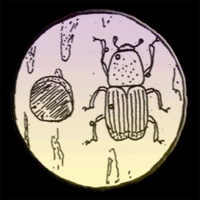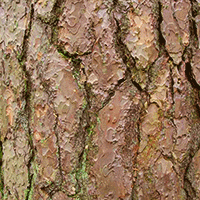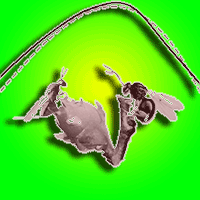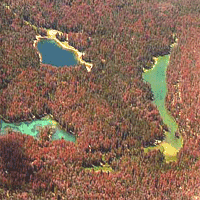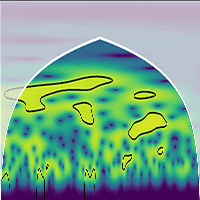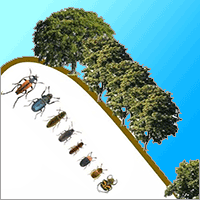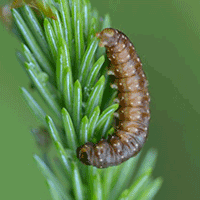
Forest health under climate change: impact of insect pests
Matteo Bracalini (1), Flavius Balacenoiu (2), Tiziana Panzavolta (1)
iForest - Biogeosciences and Forestry, Volume 17, Issue 5, Pages 295-299 (2024)
doi: https://doi.org/10.3832/ifor4520-017
Published: Sep 30, 2024 - Copyright © 2024 SISEF
Review Papers
Collection/Special Issue: Project LIFE MODERn(NEC)
Workshop "Climate change and forest health monitoring in Italy" - Rome (Italy) May 5, 2023
Guest Editors: Bussotti F, Pollastrini M
Abstract
The impact of climate change on forests is difficult to predict, as it depends on multiple factors and the final effect may vary in different parts of our planet. However, these effects can be sorted in “direct”, when they act directly on plants, and “indirect”, when they act through other agents. Among the indirect ones, there are those mediated by biotic factors, particularly insect pests. The impact of climate change on insect pests varies depending on the insect species and the type of forest. Some plant-feeding insects may be disfavoured by climate change, with a consequent reduction in population density and thus in damage to forests. However, many outbreaks of forest insects have been recently recorded as related to climate change. In fact, some insect pests, in certain regions of the world, may benefit from higher temperatures, as it has been demonstrated for some devastating defoliators. In addition, more frequent drought and extreme events may favour other pests, particularly bark beetles and wood-boring insects. Bark beetles are the most dangerous ones because their aggressiveness changes with population density. They can attack only stressed trees at low population densities, while, once the populations have reached high density, they are even able to attack healthy trees in widespread areas.
Keywords
Authors’ Info
Authors’ address
Tiziana Panzavolta 0000-0002-8985-3071
Department of Agriculture, Food, Environment and Forestry - DAGRI, Plant Pathology and Entomology section, University of Florence (Italy)
National Institute for Research and Development in Forestry “Marin Dracea” (Romania)
Corresponding author
Paper Info
Citation
Bracalini M, Balacenoiu F, Panzavolta T (2024). Forest health under climate change: impact of insect pests. iForest 17: 295-299. - doi: 10.3832/ifor4520-017
Academic Editor
Martina Pollastrini
Paper history
Received: Nov 07, 2023
Accepted: Jun 27, 2024
First online: Sep 30, 2024
Publication Date: Oct 31, 2024
Publication Time: 3.17 months
Copyright Information
© SISEF - The Italian Society of Silviculture and Forest Ecology 2024
Open Access
This article is distributed under the terms of the Creative Commons Attribution-Non Commercial 4.0 International (https://creativecommons.org/licenses/by-nc/4.0/), which permits unrestricted use, distribution, and reproduction in any medium, provided you give appropriate credit to the original author(s) and the source, provide a link to the Creative Commons license, and indicate if changes were made.
Web Metrics
Breakdown by View Type
Article Usage
Total Article Views: 13921
(from publication date up to now)
Breakdown by View Type
HTML Page Views: 9044
Abstract Page Views: 2420
PDF Downloads: 2166
Citation/Reference Downloads: 31
XML Downloads: 260
Web Metrics
Days since publication: 458
Overall contacts: 13921
Avg. contacts per week: 212.77
Citation Metrics
Article Citations
Article citations are based on data periodically collected from the Clarivate Web of Science web site
(last update: Mar 2025)
(No citations were found up to date. Please come back later)
Publication Metrics
by Dimensions ©
Articles citing this article
List of the papers citing this article based on CrossRef Cited-by.
References
A global overview of drought and heat-induced tree mortality reveals emerging climate change risks for forests. Forest Ecology and Management 259 (4): 660-684.
CrossRef | Gscholar
Climate change and forest disturbances: climate change can affect forests by altering the frequency, intensity, duration, and timing of fire, drought, introduced species, insect and pathogen outbreaks, hurricanes, windstorms, ice storms, or landslides. BioScience 51 (9): 723-734.
CrossRef | Gscholar
Responses of insect pests, pathogens, and invasive plant species to climate change in the forests of northeastern North America: what can we predict? Canadian Journal of Forest Research 39 (2): 231-248.
CrossRef | Gscholar
Scientists’ warning on climate change and insects. Ecological Monographs 93 (1): 1976.
CrossRef | Gscholar
Drought-induced positive feedback in xylophagous insects: easier invasion of Scots pine leading to greater investment in immunity of emerging individuals. Forest Ecology and Management 270: 147-152.
CrossRef | Gscholar
Thresholds in the life cycle of the spruce bark beetle under climate change. Interjournal for Complex Systems 1648: 1-10.
Gscholar
Ecological consequences of climate change altered forest insect disturbance regimes. In: “Climate Change in Western North America: Evidence and Environmental Effects” (Wagner FH ed). University of Utah Press, Salt Lake City, UT, USA pp. 98-109.
Gscholar
Aphids response to drought stress hypothesis vary between species. Open Access Library Journal 10: 1-18.
Online | Gscholar
Forests. In “Impacts, Risks, and Adaptation in the United States: Fourth National Climate Assessment, Volume II” (Reidmiller DR, Avery CW, Easterling DR, Kunkel KE, Lewis KLM, Maycock TK, Stewart BM eds). US Global Change Research Program, Washington, DC, USA, pp. 232-267.
CrossRef | Gscholar


